Of late I’m often asked whether anything remains of the place that is referred to, in River of Smoke, as ‘Fanqui-town’ .
[‘View of the Canton Factories’ by William Daniell, 1805-6*]
This is of course the old Foreign Enclave in Canton (Guangzhou) which was also known as the ‘Thirteen Factories’ (Saap Sam Hong).
[The Thirteen Factories as depicted in a reverse-glass painting §]
The answer to the question is no: nothing remains of the Thirteen Factories today. They were burnt down in 1856 and never rebuilt. Instead a new foreign enclave was constructed on a reclaimed mud-bank called Shamian.
This model of historical Canton gives us an idea of the location of the Thirteen Factories in relation to the old walled city.
The Thirteen Factories were located at the south-western edge of the city (bottom left hand corner), just beyond the city walls and the south-west gate. The position of Shamian Island is not clearly indicated on this map, but it was somewhat to the west of the Thirteen Factories.
The newly-built foreign enclave on Shamian Island bore little resemblance to the old Thirteen Factories: it was a settlement in the mid-19th century European-colonial style
and Chinese people were not allowed to enter it except with special permits. It was connected to the city by bridges which could be sealed off in case of trouble.
Shamian has survived pretty much intact. It is much visited by foreigners and its hotels are popular among those who go to China to adopt children.
Many of its buildings are well-preserved
and some stand upon interesting foundation stones.
Some of the buildings have been turned into boutique hotels, bars and restaurants.
In the last century and a half Guangzhou has changed dramatically. The old city walls were torn down early in the twentieth century, and the riverfront has been hugely altered through reclamation. The most prominent sights and landmarks mentioned by 18th and 19th century travelers have almost all disappeared, including the island from which (according to one legend) the Pearl River took its name – it was known to European travelers as the ‘Dutch Folly’ (and ‘Pearl Island’ to the Cantonese).
[‘Dutch Folly Fort’ by George Chinneryn ß].
The Pearl River at Guangzhou is now much narrower than it was in the 19th century and many massive buildings, roads, and walkways have been constructed on the reclaimed land.
The southern bank of the river, which was known to travelers as ‘Honam Island’, has perhaps changed even more dramatically than the opposite shore. In the past this island was a kind of country getaway, and was much less built-up than the other bank, being lined mainly with temples, country estates and gardens.
[Looking south towards Honam Island from the roofs of the Thirteen Factories; early 19th century **].
Now the south bank has been completely incorporated into the city. 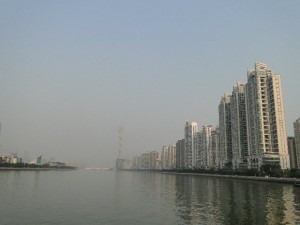
And the stretch of shore that would have been directly aligned with the Thirteen Factories has become a paved walkway.
There remains only one living trace of the Thirteen Factories: this is the street that marked the foreign enclave’s northern boundary. Known as ‘Thirteen Factory Street’ it was described by travelers as a busy, crowded thoroughfare, packed with shops and stalls. Much of the tea, porcelain, silk and other goods that were exported from China found their way to the world through this street.
[Silk Shop, c. 1825 Guangzhou ***]
Shop, Guangzhou, 2011
This street is still known as ‘Thirteen Factory Street’ (Saap Sam Hong Lu). Travelers who visit it in the expectation of viewing a quaint remnant of the past will be disappointed.
It is now the centre of Guangzhou’s wholesale garment export industry
and has become even busier and more crowded than it was in the past. It is in fact the busiest market I have ever seen – if Calcutta’s Bow Bazar, Bombay’s Crawford Market and Cairo’s Khan el Khalili were crammed together in one place I doubt they would generate as much activity as Thirteen Hong Street on a weekday morning.
To me it seems a triumph of historical continuity that this street has remained so true to its character.
But disappointed nostalgists can always console themselves by walking down a street that offers mannequins
and wigs
and through a square with a statue that commemorates Canton’s mercantile past,
to one of the city’s famous dim-sum restaurants
where friendly diners will help them pick out the best that Canton has to offer.
And when the feast ends, they can work it off by going for a walk along White Swan Lake, where the Pearl and North rivers meet.
———————————————————-
* With thanks to the MIT Visualizing Cultures Project: http://ocw.mit.edu/ans7870/21f/21f.027/rise_fall_canton_03/cw_essay01.html
§ Courtesy MIT Visualizing Cultures Project, see above]
ß Peabody ‘Essex Museum, photo Jeffrey R. Dykes (courtesy MIT Visualizing Cultures site, see above)
** (courtesy MIT Visualizing Cultures Project)
*** China Gouache on paper Gift of Mr. & Mrs. B. Rionda Braga, Peabody Essex Museum 2007 Photo Jeffrey R. Dykes (courtesy MIT Visualizing Cultures Project)



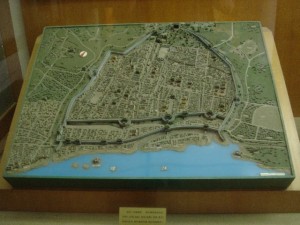
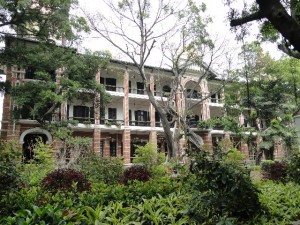
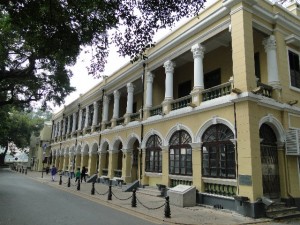

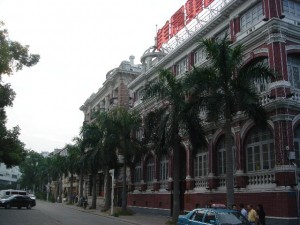


 [
[

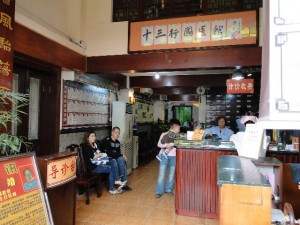
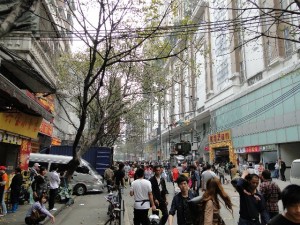


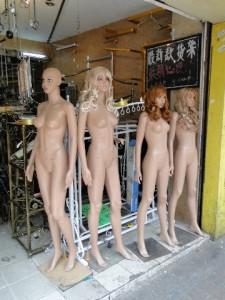

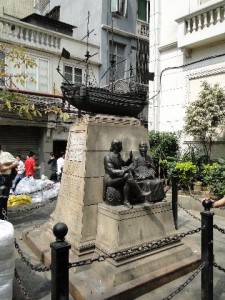

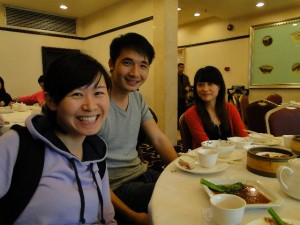
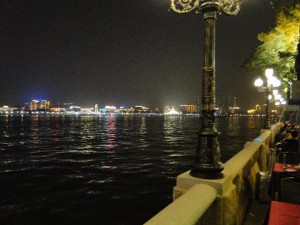
I am glad i came across this blog. 🙂 I loved the pictures. It must have been a wonderful experience.
River of Smoke made me really curious about Canton, macau, Hongkong, and the Pearl River. This is what made me google it and search for information about these places during this time period. (And of course disappointment that nothing is left now of the thirteen hongs!)
But most importantly, I am thrilled to discover the level of research that Mr.Ghosh puts into each of his books. It is understandable that that is required for a non-fiction book like Countdown, but when an author puts the same level of commitment and research into writing fiction, it makes me feel good about being the reader. It shows a certain level of respect that he has for his readers and that he does not take us for granted.
I am well and truly a fan!
Thank you, Amitav Ghosh for hours and hours of new worlds, new words and new experiences! The books in this trilogy surpass even “In an Antique Land”, which I thought was your absolute masterpiece!
Please don’t take too long to publish the third book!
-Kaveri
Thanks very much for this Kaveri! I’m touched…
Dear Sir,
I finished River of Smoke a week ago and I can still see the Hong settlement, Bahram Modi, Neel, Baboo Nob Kissen, the Co-Hong merchants, the Madarin army et al when I close my eyes!…And I did not need opium to conjure up these visions…your style and narrative were the drug that produced this brilliant scene :).
Thank you so much for this wonderful book. I truly admire your research and imaginative abilities in making this tale so intoxicating for us.
Also, proud to be an Indian and to ruminate the diversity of our land!
thanks very much, Amina!
Amitav
Dear Sir,
It has been such a pleasure and so very interesting to read the two books, Sea of poppies and River of smoke. Finished the River of smoke a week ago and it still sticks in my mind. It makes me think and reflect. My knowledge of history is from “the Dutch site”. Also I had to google for more information about this period in history and was glad to find this site. I am impressed by the width of your knowledge of plants, paintings, food, culture clashes and boat life. The way you put it all together feeds my fantasy. It also makes me think about todays problems with drugs and culture clashes and what we have (not) learned from the past.
The way you write your stories realy widens the mind and engages.
I am very much looking forward to your third book.
Wishing you good luck and lots of inspiration.
Thanks very much!
A
I enjoyed this post a lot. A family member owns one of the 19th century paintings of the 13 factories area; as a child I used to examine it trying to identify/count all the flags. I’ve always wondered about that time/place so now I will read River of Smoke!
Former MIT employee (1979-87) and still miss the place…
Dear Mr Ghosh,
a similar comment of praise from me: I finished “River of Smoke” a few days ago, and that world is still with me. I am a landscape painter and illustrator, twenty years ago I spent a sweat-drenched month working in Hong Kong, doing studies for an illustration about the then-new Western Harbour Crossing. I was fascinated by the area, I also visited Macau. China was then hard to get into. But your book brought back memories aplenty, your vivid style certainly brought everything to life in 3D!. I could sympathise with Robin, I have been in some similar situations. Also, Mauritius is a little familiar, as is sailing in an 18th Century vessel: back in 1987/8 I took part in the First Fleet Re-Enactment aboard HMAV Bounty, a sailing replica of the famous ship of mutiny fame. So some of the atmospheres you describe so evocatively are a little familiar to me still, even if it is some twenty-odd years ago. And for the worlds I never knew: you certainly have added to my wonder and respect of them.
I wish you the best of inspiration and fortitude with the next book, count me among your fans!
best regards –
Oliver Rennert
Thank you Oliver -I really appreciate your taking the time to write!
AG
Dear Mr. Ghosh,
As a big fan of Sea of Poppies and River of Smoke (which I read as soon as it came out), I used my one free afternoon to try and find the site of the 13 factories. While I did find Saap Sam Hong Lu, I did not find the Fanqui-town site. I had done a bit of research, and had learned, or had been misinformed as the case may be, that the site is currently occupied by Wenhua Park (which I did not locate). Do you know if this the case? ( I didn’t find the park as I am not as adept an American as your wonderful “Zachry” Reid.). I was disappointed because your wonderfully wrought book made me want to stand on the site and reimagine the melee when Bahram Modi attempted to get the shipment in.
I look very much forward to the finale of the trilogy!
Best,
Matt Carswell
St. Louis
The ‘Fanqui-town’ site doesn’t exist in that form any more. It was burnt down in 1856 and never rebuilt. After that the foreign enclave moved to Shamian Island. Saap Sam Hong Lu is actually the only remnant of the 13 Factories site. It marked the outer boundary of the foreign enclave. The enclave lay between that street and the river extending for about a couple of hundred yards (the river was much closer to the Saap Sam Hong Lu at that time). I hope this helps.
Amitav
While reading River of Smoke it struck me that perhaps Fanqui-town, an exciting part of the city of Canton where a lot of action in the book takes place, has been metamorphosed to Funkytown. You know the famous 80s disco song by Lipps – ‘Won’t you take me to Funkytown’.
Best,
tapo
mumbai
I happened on this site while web surfing and really enjoyed it. Twenty years ago today I left Guangzhou after living on Shamian Island for three years. The 10th picture is very much like the view I had from my living room window. It hadn’t changed that much – back then. I haven’t been back since I left so I don’t know what it looks like now. Thirty years ago I lived in Hong Kong, in the mid levels just west of the university. I was there for three years as well. I loved living in both places and your site brought back many memories. I will be making a trip to the books store as soon as possible to find your books.